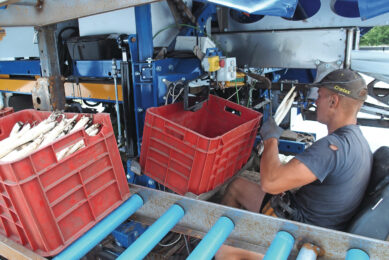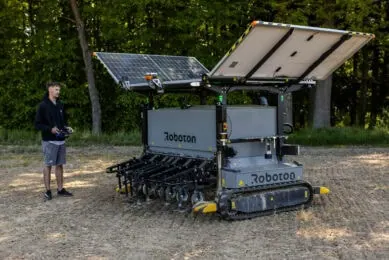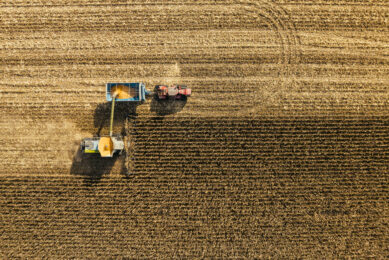Autonomous tractors require new ‘drivers’

“As a company, we are always interested in innovative technologies. It seems inevitable that an autonomous tractor will be deployed on our farm in the future,” says Kees Klok, who, together with his brother Arjo, runs a land development and contracting company as well as a nature-inclusive arable farm. “The days when a good driver was someone who could shift gears and drive in straight lines are over. The operator of a modern tractor—especially an autonomous one—needs to have entirely different skills.”
We meet Kees Klok at the iQuus-autonomously equipped Fendt 516, which is working with a rotary tiller on a sports field. Kees and his brother Arjo run a contracting, land development, and nature-inclusive arable farming business in the Netherlands, hence the tractor operating on a sports field.

Ton Tanis is the regular operator of the tractor. Although the term ‘operator’ has become somewhat relative in this context. Ton has already used the Fendt to ted and rake grass and has prepared land for bean sowing using a power harrow. “At this point, we are still experimenting with the tractor,” Ton explains. “We have done relatively small tasks that might not be the ideal applications for this tractor, but they are a good way to get familiar with the technology and explore its potential. The more hours a task requires on the same plot, the more attractive autonomous operation becomes.”
Works quite well
“After an initial explanation from the iQuus team, working with the tractor was fairly easy,” says Ton. “It helps that we are already familiar with Fendt tractors and RTK GPS on our farm. We usually work with Trimble and Massey Ferguson; the iQuus Fendt uses a Raven GPS system.” During operation, Ton did encounter the occasional hiccup, “but,” as he points out, “the contact person at iQuus was always easily reachable and could quickly assist.” One function Ton has not yet managed to activate independently—but which the tractor is capable of—is reversing while turning on the headland. On the sports field, Ton had to adjust a setting because the tractor came too close to a barrier net at the field’s edge while turning. “The tractor then stops, and you have to help it resume movement.”
Safety is an important aspect of autonomous tractors, and this machine appears well-equipped in that regard. “Safety is also something we take very seriously in our business,” adds Kees.

New cameras
Up to now, iQuus has relied on radar to detect obstacles for safety. This year, the company is trialling a combination of vision camera and radar for the first time. Technically, this creates significantly more data traffic and some limitations, as the team seeks optimal settings that minimise data use while maintaining functionality. However, the safety systems of this tractor seem robust from the operator’s point of view. As soon as you step on or off the moving tractor, it comes to a halt. It even stops when the cab door is opened. Inside the cab, all settings can be configured, but to get the tractor moving without a driver behind the wheel, the operator must first step off. The tractor is then started, stopped, or paused using the remote control.

Suggestions
Despite positive experiences, there are some suggestions and ideas for improvement. When attaching an implement to the tractor, it would be preferable if emergency stop functions were also present on the implement itself. Various headland turning methods and working patterns can be programmed, but more options could be added. While preparing the land for beans, differences in soil heaviness arose, prompting the desire to adjust forward speed to maintain consistent soil crumbling. Currently, the tractor only drives at a fixed pre-set speed. It would be conceivable to link speed to a task map, for example. Additional systems to monitor implement performance are also desirable. This is a common request among companies considering autonomous tractors.
Autonomous mowing with a rear mower could have been a suitable application for Klok. However, this would create an asymmetrical setup, causing the mower to double up or miss passes. It would be useful if this too could be programmed. Being able to read the tractor status on a smartphone is helpful, but with vision cameras now installed, live monitoring would also be a logical next step. If the tractor stops, remote viewing could help determine the cause and provide insight into the quality of the work. The technology is onboard but not yet activated for Klok. If the tractor comes to a standstill, it would also be useful if, after a certain time, it would disengage the drive and shut off the engine.

New “drivers” needed
“We definitely see opportunities on our farm,” says Kees. “Labour is expensive and scarce, so we are always looking for solutions. Ton was baling grass on the plot while the Fendt was raking it unmanned. That way, one person operates two machines. If something goes wrong, you are nearby to fix it.” Tasks where the tractor operates while the ‘driver’ does other work seem logical and can lead to cost savings.
On the other hand, although many tractors and machines are already semi-autonomous, at this stage you cannot simply assign just anyone to operate an autonomous tractor. The time when a good tractor driver was defined by gear shifting and straight driving is over. A modern tractor operator—and especially one of an autonomous machine—needs a different skillset. “Ton enjoys this kind of work and is interested in the technology, which makes him the ideal candidate to work with the iQuus system,” Kees concludes after this first experience with iQuus autonomy.



